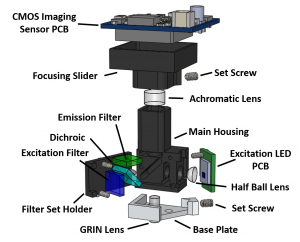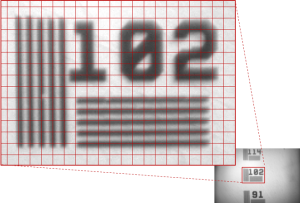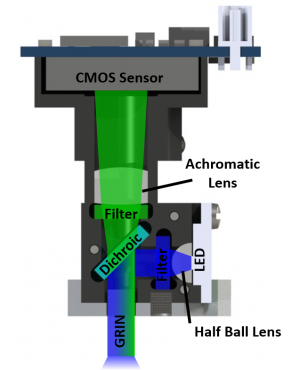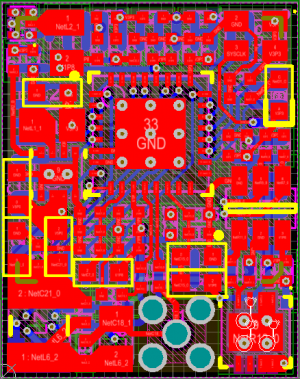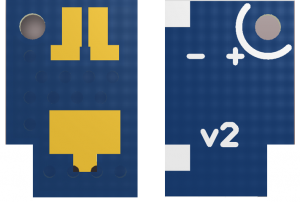Head Mounted Scope
Contents
Overview
The head mounted scope consists of a machined Delrin housing, optical filters and lenses, an excitation light source, and CMOS imaging sensor. The mass of the system in under 3 grams and connected to the DAQ hardware using a single coaxial cable. The body and optical components can be easily hand assembled using only forceps and a torx T2 driver. Optical filters are slide in from the side of the scope and held in place with a filter cover plate. The excitation half sphere lens sits in a spherical cutout and held in place by pressure from the LED PCB (optical glue is optional). The achromatic lens is slid through the top emission hole and either press fit into place or optical glued.
Adjustment of focal plane is achieved through adjusting the distance between the CMOS imaging sensor and other optical elements. The CMOS imaging sensor is mounted onto a sliding focusing mechanism which is moved by hand and locked in place with a 00-80 setscrew. Roughly speaking, movement of about 5mm of the CMOS imaging sensor results in a focal plane change of ~150um.
The scope attaches to the head of the animal with the use of a small aluminum baseplate. The baseplate and scope have a matching set of 3 rare-earth magnets which helps with mounting the scope on an awake animal. Once the scope is in place a 00-80 set screw is used to fix it in place.
Optical Path
The optical path of the miniature microscope is very similar to a tabletop wide-field fluorescence microscope. The main difference is the size of the optical elements and the use of a GRIN lens as an objective.
The optics in the miniscope use off the shelf lenses and diced commercial filters. Excitation light generated by an LED passes through a half-ball lens to help collimate the light which is then bandpassed through an excitation filter and reflected using a dichroic mirror.
Emission light exits the objective GRIN lens in roughly a parallel orientation, passes through the dichroic mirror and then bandpassed through an emission filter. The light is then focused onto the CMOS imaging sensor using an achromatic lens.
Machined Delrin Housing
The housing of the miniature microscope is machined out of pastic (we suggest using Delrin) and consists of a main body, filter set holder, and focusing slider.
Aluminum Baseplate
The baseplate is cemented to the animal's skull and provides the interface for temporarily connecting the miniature microscope to the animal. Three pairs of magnets on the baseplate and bottom of the microscope help snap the microscope in place and aid in placement when working with awake, freely moving animals. Once the microscope is placed in the baseplate, a 00-80 setscrew locks the scope in place. The setscrew applies a force along both sides of the scope making the mount very stable.
CMOS Imaging Sensor PCB
Excitation LED PCB
The excitation LED PCB is a simple 2 sided PCB with solder pads for a Luxeon SMD LED and wires to power the LED. The PCB acts as a small heat sink and has a 1mm mounting hold for attaching it to the miniscope body. The LED is powered by a constant current source on the CMOS imaging sensor PCB and controlled through an 8bit DAC.

